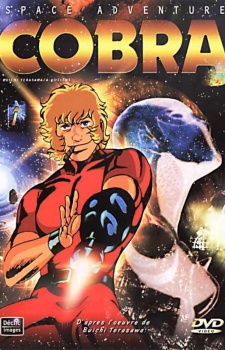
Space Adventure Cobra is a psychedelic journey through space, written at a time where space was mostly under the purview of political and humanist drama. Maybe that's not totally fair when it aired alongside Ishiguro Noboru's Super Dimension Fortress Macross and right before his Super Dimension Century Orguss, which both had a similar retro vibe, but as far as space shows go even Johnny Bravo is a better comparison. But instead of looking to space, looking to Europe we can see Space Adventure Cobra as more of a reaction to the character of Sean Connery's James Bond—or rather his French counterpart the chiseled but suave Jean-Paul Belmondo—and at home to the prolific antihero (and equally European) Lupin III. Because the aesthetic of Space Adventure Cobra is one part an 80's adventure through space, with hot spies opposing mega-corporations in a mix between Blade Runner and a disco club, and two parts Cobra, the larger-than-life playboy pirate with a gun for an arm and insatiable lust for everything he can get his other hand on.
It's hard to say if Dezaki Osamu could've made Space Adventure Cobra without Lupin III around. The show flits between genres, from a treasure quest for a supernatural weapon of mass destruction to a high-stakes baseball game, with the constant factor being Cobra's grandstanding humor, grand schemes, and penchant for winding up in trouble for the sake of money and women. Almost every episode has another cookie-cutter babe for him to chase, while a few actually show off his sensitivity towards the women who support him through his quests. And of course at the end of every episode, we're guaranteed that whatever trouble he went through, he didn't learn a damn thing from it.
It's hard to tell exactly where the show's charm lies. From a plot perspective there are three or four arcs that last longer than an episode, and only the first and last ones are really substantive. From an animation perspective we get plenty of Dezaki's usual shots, especially the painted freeze-frames at the middle and end of each episode, but even for the time the visuals weren't shocking. The music is jazzy and funky as one would hope, but no track stood out the same way as Lupin III's classic theme, or even the soundtracks of later works like Cowboy Bebop. And aside from Cobra, it's hard to say that anyone has much of a personality.
But funny enough when I look back from the last episode, all the clouds have a silver lining that makes me think fondly of it nevertheless. The focus on Cobra instead of any of the rest of the cast lets the episodic stories work because what we're really invested in is how Cobra will get himself in and out of trouble without breaking a sweat, and then when the two bigger arcs come in we get a surprising emotional punch on the side. The animation is average but the coloring is emblematic, and special care was put into a few recurring shots like Cobra's powerful arm cannon firing a blazing arc across the screen. And maybe it's not fair to say soundtracks like Cowboy Bebop are more enigmatic when such a perfect fusion of jazz and space opera might never have been born without Space Adventure Cobra breaking the mold.